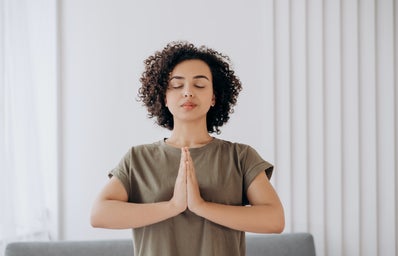First, let’s address the question of what mindfulness meditation even is. As the name suggests, it’s a combination of meditation, a set of techniques that encourage a heightened state of awareness and attention, and mindfulness, a mental state focused on being in the present. Together, mindfulness meditation involves being aware of the present moment and paying attention to both the body and the mind.
Mindfulness meditation encourages focusing on the “now,” and it has numerous benefits. Practicing this form of meditation has been attributed to an array of health benefits, including reduced stress, controlled anxiety, greater positive emotional health, decreased blood pressure, and enhanced self-awareness.
One study found that mindfulness meditation reduced feelings of loneliness and increased socialization. On top of that, it’s also been linked to strengthened focus and attention — a critical bonus for students, workers, or employees. Mindfulness meditation has also been found to reduce age-related memory loss. The list continues, as this practice also aids in fighting addiction through strengthened self-awareness, impulse control, sleep improvement, and even pain control.
Speaking of pain, modern research has concluded that practicing mindfulness meditation can reduce pain, improve quality of life, and even decrease symptoms of depression in people suffering from chronic pain. Not only that, but researchers have also studied its role in improving the immune response. Furthermore, mindfulness has been connected to increased self-acceptance, enhanced interpersonal relationships, and improved patience.
Awesome, right? Now comes the hard part: implementing and practicing mindfulness meditation on a regular basis. While it may initially sound easy to accomplish, most people have been conditioned by the “noisy” modern world to be unable to focus on the present and on our minds and bodies. I personally struggle with staying awake during sessions of mindfulness meditation because I feel unsettled by the quiet. I’m also uncomfortable with taking a breather from my day knowing I have X number of assignments to complete or Y number of tests in the coming week.
Traditionally, steps for practicing mindfulness meditation include: taking a seat, straightening your upper body, dropping your chin, and being present in the moment. You can either sit in silence or follow a guided mindfulness meditation recording. Many “how to” sites also reference entering a state of mindfulness meditation by focusing on your breathing as an anchor. However, a common gap in advice is how to do so without losing focus — or, in my case, without falling asleep.
Through trial and error, I’ve compiled a list of tips for successfully practicing mindfulness meditation to hopefully help your meditation practice!
- Sometimes you’ll fall asleep, but just think of it as a much–needed nap for your body. Do not let it deter you from trying mindfulness meditation again!
- Let your mind wander if it needs to, but always attempt to bring it back to the present by focusing on your breathing.
- If you find it difficult to just focus on your breathing, try counting: six seconds inhaling through your nose, hold for seven seconds, and breath out through your mouth for five seconds. This was especially helpful for me when I started since counting also helped prevent my mind from wandering.
- Sitting is doable and standing is alright as well. Unless you’re a master at mindfulness meditation, don’t lay down — you’ll fall asleep, guaranteed!
- Find the guided meditation strategy that works for you: Try to listen to shorter guided meditation videos first (less than five minutes), and work your way to longer ones. I find that jumping straight to a 30–minute or even ten–minute mindfulness meditation session when you first begin may end with you falling asleep and waking up hours later. However, everyone is different; some people might find they’re better-suited for longer meditations.
- Voice matters! Sometimes, guided meditations are narrated in a way that makes me lose focus or puts me to sleep easily. Experiment to find the voice — be it low–pitched or high–pitched, accented or unaccented, fast or slow, loud or soft, etc. — that works best for you!


